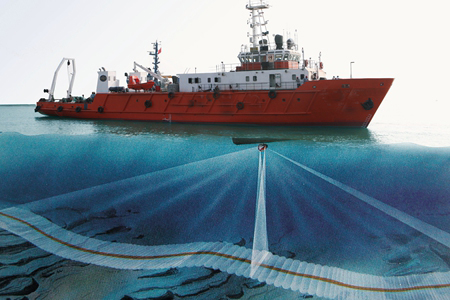‘We have more detailed maps of other planets than we do of our seabeds.’ Senior Lecturer in Geosciences Dr Aaron Micallef takes us on a journey to the bottom of the sea and explains why it’s so important to understand it.
 It is estimated that less than five per cent of the world’s oceans has been properly explored , which is mind boggling when one considers that water covers 70 per cent of the surface area of the Earth and that we have detailed maps of Mars available at the click of a mouse. Indeed, we cannot even begin to fathom just how much there is still left to discover: unknown species, forgotten civilisations, geological wonders…
It is estimated that less than five per cent of the world’s oceans has been properly explored , which is mind boggling when one considers that water covers 70 per cent of the surface area of the Earth and that we have detailed maps of Mars available at the click of a mouse. Indeed, we cannot even begin to fathom just how much there is still left to discover: unknown species, forgotten civilisations, geological wonders…
This reality becomes even more confusing when keeping in mind the importance of the world’s seas… They have been a constant source of food, transport, trade and inspiration since the dawn of time. Even today, the sea remains a vital part of world commerce, communication and transport, uniting nations in ways the aviation industry may not fully be able to yet.
“I’ve always been fascinated by geology and geography,” says Dr Aaron Micallef, who works at the Department of Geosciences within the Faculty of Science at the University of Malta; a department that has just celebrated its first year of existence. “But one thing I could never understand is why we know so little about the floor of the sea when there are so many resources there… It makes no sense!”
Over the past few years, Dr Micallef has been sailing the seven seas working on mapping the ocean floors, with its caves, landslides and geological formations. The data collected — from the seas around Malta, as well as from the Atlantic and the Pacific — is vast and fascinating to say the least but, more importantly, it can prove vital to countries and multinational corporations.
“During our first study of the Maltese seafloor, we discovered 20 valleys, 4 caverns [collapsed caves] and potential fossilised sand dunes,” continues Dr Micallef. “Through all this we learn more about what affects the sea floor and about geo-hazards, which can be quite dangerous for humans and society, both physically (though earthquakes, tsunamis, etc.) and even financially (such as if a landslide affects Internet or electrical pipelines).
“We also learn more about the protection of bio-resources, like ecosystems, gas, oil and minerals — the latter of which are used to create so many different things we use on a day-to-day basis, including the electronics in laptops and mobile phones.
“What many don’t understand — and science still has a lot to learn about — is that something like a submarine landslide, which is formed from mud and rock that becomes displaced, can have huge consequences on our lives. I mean, these can be absolutely huge… In fact, the biggest one discovered so far in the world is the size of Portugal!”
Moreover, the data being collected is revealing incredible new facts about the world around us; information that could help us piece together major events that affected the course of history throughout the last 5,000,000 years, including changes in climate that could, potentially, take place again in the future.
“Currently we are working on the Marie Curie Project Scarp, which focuses on Malta Escarpment [a long, steep slope],” explains  Dr Micallef. “This is a 4km-long cliff and it’s the most prominent feature in the Mediterranean, yet no one knows how it was formed. The study is incredibly important and there are people from Italy, Ireland, the UK, New Zealand and, of course, Malta, working on it… So far, we have discovered over 200 submarine canyons and a further 200 landslides here, and we’ve even identified similarities between the escarpment here and others in the Caribbean.”
Dr Micallef. “This is a 4km-long cliff and it’s the most prominent feature in the Mediterranean, yet no one knows how it was formed. The study is incredibly important and there are people from Italy, Ireland, the UK, New Zealand and, of course, Malta, working on it… So far, we have discovered over 200 submarine canyons and a further 200 landslides here, and we’ve even identified similarities between the escarpment here and others in the Caribbean.”
To create maps of the seabed, researchers like Dr Micallef use sonar technology, which uses echo, to determine distance and depth among other features, as well as robots. As one can imagine, the cost of such expeditions is enormous, with over half of the €1.7m starting grant from the EU-Fund ERC going on just vessels within the first year.
Even so, the research is simply too important to put a price on. And the new Department is one of the fastest-growing at the University of Malta, with many opportunities for those who join Dr Micallef and the rest of the team on this scientific adventure that could potentially change the way we see our planet!
Click here to read more about the Scarp Project
You can be part of this fascinating world of research, too, by helping many others achieve their breakthroughs in all the faculties of the University of Malta. Please click here for more information on how to donate to research of this kind through the Research Trust (RIDT).
